Taking on a fasting-mimicking diet (FMD) can seem daunting, especially if you’re counting calories for the first time. Inspired by the longevity research of Dr. Valter Longo and Dr. Steven Gundry, I’ve created a 5-day Fasting Mimicking Diet Meal Plan, Do-It-Yourself style. It’s a vegan, low-lectin, and relatively low-histamine plan designed to be both accessible and affordable.
This meal plan was created for my mom and me but leaves room for flexibility. Adapt it to suit your location and the available seasonal produce.
What is a 5-day fasting-mimicking diet?
Developed by biogerontologist Dr. Valter Longo at the University of Southern California, the 5-day FMD is a nutritionally rich, low-calorie diet that is designed to mimic a water fast, without entirely removing food.
Potential health benefits of a 5-day fasting-mimicking diet
The potential health advantages of this diet, as highlighted by both Dr. Longo and Dr. Gundry, include:
- Autophagy (Cell Recycling): This diet can activate autophagy, a process where cells break down and recycle damaged cells or dysfunctional components. This cellular “clean-up” may help reduce the risk of various diseases, improve cellular function, and promote overall health by eliminating cellular debris that can accumulate and cause harm.
- Detoxification: While in a fasting state, the body may enhance its natural detoxification processes. Reduced food intake can lead the body to more effectively process and eliminate toxins stored in fat cells, contributing to improved organ function and overall well-being.
- Deep Healing: A period of reduced caloric intake can give the body a break from the constant demands of digestion and nutrient assimilation, potentially allowing more energy and resources for repairing tissues and addressing underlying health issues. This might lead to improved healing processes and rejuvenation at a cellular level.
- Metabolic Reset: The fasting-mimicking diet can prompt a metabolic reset, enhancing insulin sensitivity, reducing inflammation, and rebalancing hormones. While there may be short-term weight loss due to caloric restriction, it’s important to note that this is not the primary goal of the diet. Instead, the focus is on long-term metabolic health improvements, which can potentially reduce the risk of diseases like diabetes and obesity.
Cautions
While fasting benefits are undeniable, it’s crucial to always prioritize safety. If you have medical conditions or a history of eating disorders, consulting your medical provider before embarking on this diet is essential.
Dr. Valter Longo is cautious regarding DIY fasting-mimicking diets. He advises medical supervision. Please do not make any drastic changes in your diet without consulting with your doctor, especially if:
- you take medication like insulin, statins, steroids, immunosuppressants, etc
- you have diabetes, low blood pressure, cancer, compromised immune system, or other medical conditions
- you have a history of eating disorders
- you have a very low BMI or are underweight or frail
- you are over 65 years old
Resources
For more in-depth information on this topic, I recommend reading The Longevity Diet by Valter Longo, PhD or watching some of his more recent podcasts or interviews, like this one on The Dr. Gundry Podcast, published in May 2022.
The Longevity Paradox, How to Die Young at a Ripe Old Age, by Dr. Steven Gundry, was another source of inspiration for creating this meal plan.
If you prefer to start with the original Fasting Mimicking Diet (the Prolon Diet), you can purchase the 5-Day Prolon Fasting Nutrition Kit.
The latest results of years of research from Dr. Valter Longo are detailed in his new book, published in February 2025: Fasting Cancer, How Fasting and Nutritechnology Are Creating A Revolution in Cancer Prevention and Treatment.
Rules for the 5-day fasting-mimicking diet meal plan
- Calorie-Restricted: Limit your daily intake to 900 calories or fewer. According to Dr. Gundry, this mirrors the benefits of a full month of continuous calorie restriction.
- Vegan: The plan is entirely plant-based, excluding all animal proteins and dairy.
- Lectin-Light: Avoid plants with a high lectin content. Beans and legumes should be soaked and pressure-cooked to minimize lectin content, with a daily maximum of one cup (8oz).
- Whole Foods Only: No ultra-processed processed foods are allowed.
- Sugar-Free: Exclude sugars, including most fruits. A limited quantity of berries and a minimal amount of honey is acceptable.
- Nutrition-Dense: Adhere to a nutritarian approach, focusing on nutrient-rich foods that are low in calories. Don’t deprive yourself of essential nutrients. Consider incorporating microgreens and sprouts into the menu to enhance nutrition without added calories.
Transition after the 5-Day FMD
After the five days, transition with a day of plant-based, normal-calorie diet. Include complex carbs like sweet potatoes, beans, or lectin-free grains.
Note: While this plan is generally considered low in histamines, it’s essential to note that some lists may not categorize beans as such. However, many foods in this cleanse possess anti-histamine properties. If needed, ingredients like avocado and cacao can be substituted.
About sourcing and cooking methods
For optimal nutrition, prioritize sourcing local, organic, in-season produce, and try to eat a mix of both raw and cooked vegetables.
The aim isn’t perfection but making the most of what’s readily available. For instance, while residing in Romania during autumn, I wouldn’t actively seek tropical ingredients.
For a concise shopping guide and a detailed overview of lectin-free foods, refer to my article The Plant Paradox Shopping List (A Lectin-Free Food List – PDF).
Accessibility of this 5-day fasting-mimicking diet meal plan
Because I wanted to inspire my mom who joined me in this cleanse, I aimed to design a simple yet effective plan using ingredients commonly found in Romanian markets (where my mom lives).
Regardless of your location, you’ll find the list familiar and adaptable. So long as you adhere to the fundamental guidelines, feel free to incorporate locally available ingredients.
For those who have considered the original Prolon 5-day fasting-mimicking diet but found it too expensive or inaccessible, consider this your starting point. Once you’ve understood the basics, adapt this plan to suit your preferences.
Beans and legumes, preparation and storage
In this diet plan, beans and legumes will be a part of every meal. It’s essential to soak and pressure-cook them to reduce harmful lectin levels.
Lentils are rinsed thoroughly and pressure-cooked for 15 minutes, without soaking. But be careful, some lentils can go to mush if overcooked, so is better to stick to green lentils, also called French lentils, as they hold their shape well.
Chickpeas, on the other hand, should be soaked overnight, rinsed multiple times, and pressure-cooked for approximately 24 minutes. To ensure optimal cooking, I don’t add salt to the cooking water.
Black beans require a solid 25-minute pressure cook.
Efficient bean preparation
For a hassle-free experience with the DIY fasting-mimicking diet, prepare beans beforehand and freeze them. This allows you to directly use them for stews or other dishes.
Organic canned beans that have been soaked and pressure cooked are also an option. In the United States, Eden and Jovial brands are my favorite choices.
Bean stewing is straightforward. Begin with a small amount of extra virgin olive oil (or an oil of your choice), sauté onions until they’re aromatic, add garlic and beans, and pour a bit of water to prevent sticking.
Should you opt for other greens, like kale, add them towards the end of the cooking process. Fresh herbs like parsley and cilantro enhance the flavor profile and the nutrition of the dish.
Dive deeper into the world of beans with my article: Reintroducing Beans. Three Easy and Delicious Recipes.
Freeze beans in Souper Cubes
Meal planning doesn’t inherently resonate with me, given my impromptu cooking style. Yet, certain hacks have considerably simplified my cooking process.
Pre-soaking, pressure-cooking, and freezing beans and lentils in separate portions are my top recommendation. I use Stasher bags and Souper Cubes.
Spices and salt for the 5-day fasting-mimicking diet meal plan
During my cleanse, I embraced simplicity, using Herbs de Provence, complemented by salt and pepper.
Enhance flavors using fresh herbs like cilantro, parsley, dill, rosemary, thyme, oregano, and basil.
Although pesto is a great addition to everyday meals, it is problematic during this cleanse due to its high-caloric content from oils.
Speaking of seasonings, adjust salt to your palate. Remember, salt is vital, especially when cutting out processed foods laden with it. I opted for Himalayan pink salt. For those in the US, I’d recommend mineral-rich Redmond Real sea salt or a good quality iodized sea salt.
Alternatively, introduce seaweeds into your meals for a burst of umami and a natural source of iodine.
Counting calories for the 5-day fasting-mimicking diet meal plan
While I never typically count calories and would advise against it in normal circumstances, when adhering to a calorie-restricted meal plan, it’s unavoidable.
I realized during this process that it’s easy to underestimate our caloric intake. Thus, careful portion control was crucial to maintaining a daily intake of under 900 calories, especially when it came to oils, nuts, beans, and starchy vegetables.
Calories in beans and oils
While beans and legumes are part of this plan, it’s important to monitor your consumption due to their calorie content. This plan recommends a maximum daily intake of 8oz (1 cup) of beans or legumes.
To make the experience more palatable for my mother, I incorporated chickpeas and lentils in nearly every meal, but I kept it to a maximum of 1/2 cup per meal.
Oils are another high-caloric food that we need to monitor. My choice of oils for this plan are extra virgin olive oil, coconut oil, and sesame oil.
Here’s a rough breakdown of the estimated calorie content for the ingredients that are calorie-rich:
- 1 cup of boiled lentils – 230 calories
- 1 cup of boiled chickpeas – 267 calories
- 1 cup of boiled black beans – 227 calories
- 1 tablespoon of extra virgin olive oil – 119 calories
- 1 tablespoon of avocado oil – 124 calories
- 1 tablespoon of coconut oil – 117 calories
- 1 tablespoon hemp seed oil – 126 calories
- 1 tablespoon tahini (sesame seed butter) – 89 calories
- 2 tablespoons hemp seeds – 111 calories
- 1 Brazil nut (1 kernel) – 33 calories
- 10 olives – 59 calories
- 1 cup full-fat coconut milk (canned) – 552 calories
Preparing sweet potatoes
While most vegetables and greens have a low-calorie content, and you shouldn’t stress about how much you are eating, starchy vegetables like sweet potatoes require monitored portions.
100 grams of cooked sweet potato, which is a little less than 1/2 cup, has 86 calories.
Sweet potatoes should be cooked, cooled, and then reheated for enhanced nutritional benefits. This process increases resistant starch and ensures slower sugar absorption.
I love to bake them whole, cool them overnight, or for a few hours, then reheat them before serving.
Preparing non-starchy vegetables
Consuming vegetables in various forms, from raw, to steamed, to roasted, is beneficial to maximize nutrient intake.
While I like raw cauliflower, I usually cook broccoli. Similarly, I enjoy both raw cabbage salad and roasted cabbage.
If you have trouble digesting raw vegetables, swap the raw vegetables in this plan with the cooked version.
Here’s a calorie breakdown for some of the vegetables used in this plan:
- 1 head large cauliflower (840g) – 209 calories
- 1 bunch broccoli (608g) – 205 calories
- 1 medium onion – 44 calories
- 1 cup chopped cabbage – 22 calories
- 1 bulb fennel – 73 calories
- 1 raw carrot – 30 calories
- 100g raw beets – 43 calories
- 200g asparagus – 40 calories
- 100g sweet potato (approx. 1/2 cup) – 86 calories
The 5-day fasting-mimicking diet meal plan
There are different ways to split the allowed food/calories throughout the day, but we chose two meals a day: lunch and early dinner, which is our regular schedule anyway.
Our first meal was around noon, and dinner was no later than 6 pm. Sometimes we had snacks in between and coffee in the morning.
Don’t bother counting calories for non-starchy vegetables, as they are very low in calories. Monitor only the high-calorie ingredients: oil, beans, nuts and seeds, and starchy vegetables.
Day 1
Ingredients: Extra virgin olive oil (EVOO), hemp seed oil, red onion, leeks, cauliflower, asparagus, fennel, garlic, ginger, hemp seeds, sweet potato, cooked lentils, broccoli, arugula, olives, herbs de Provence.
Meal 1: Veggie Hash with Leeks, Cauliflower, and Asparagus (246 calories)
- Sauté leeks, onions, and ginger in a small amount of oil until translucent. About 1 tablespoon of oil for 2 servings should suffice.
- Add garlic, followed by cauliflower (either riced or finely chopped).
- After a few minutes, add the chopped asparagus.
- Season with salt, pepper, and Herbs de Provence.
- Garnish with hemp seeds and a light drizzle of olive or hemp seed oil. For caloric values, refer to the ingredient list above.
Meal 2: Buddha Bowl with Lentils, Sweet Potato, and Broccoli (317 calories)
- Sauté red onion, then mix in lentils and fresh garlic, cooking until creamy.
- Season and possibly add parsley or cilantro for garnish.
- Pair with steamed broccoli florets, pan-seared slices of pre-baked sweet potato seasoned with Herbs de Provence, and a side of green salad or arugula, topped with olives.
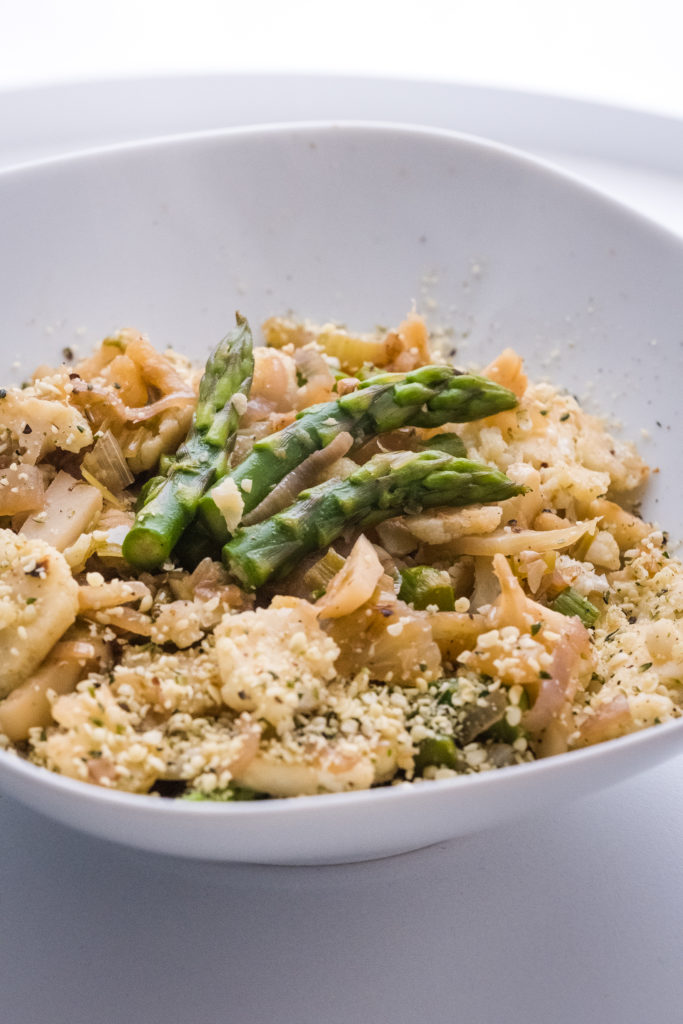
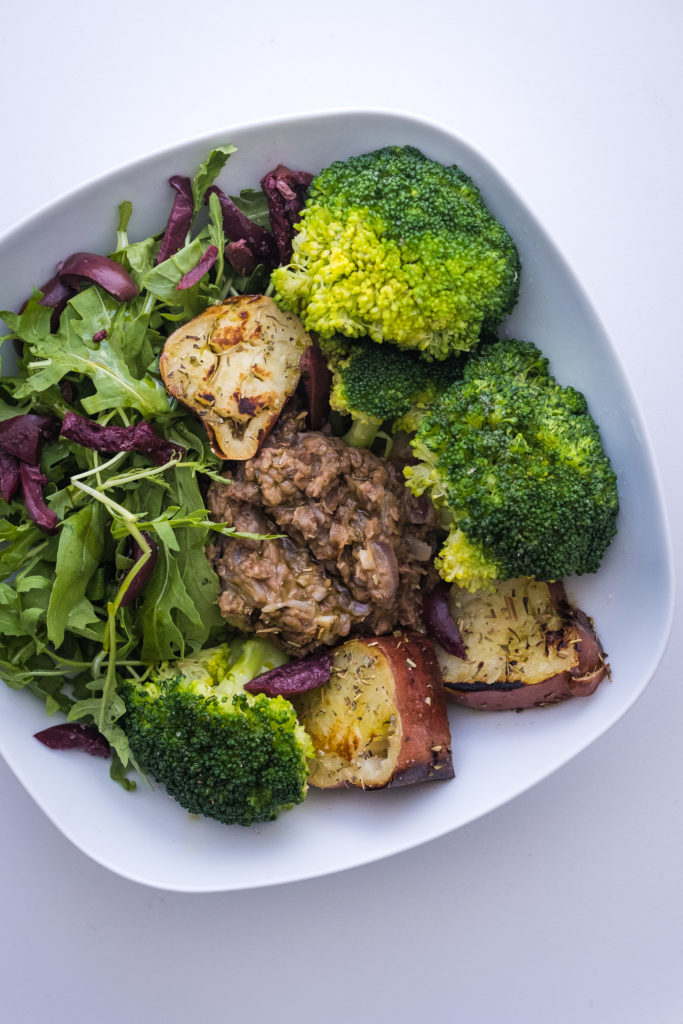
Day 2
Ingredients: EVOO, hemp oil, kohlrabi, avocado, carrot, asparagus, olives, figs, arugula, chickpeas, tahini, nigella sativa seeds, red cabbage, leeks, fennel, ginger, cloves, mache salad, sweet potato.
Meal 1: Veggie Platter & Hummus (456 calories)
- To make the hummus, mix in a blender: 1/2 cup chickpeas per serving, 1/2 teaspoon tahini per serving, 1 teaspoon extra virgin olive oil per serving, lemon juice, salt. Optionally you can add cumin and garlic. Sprinkle with some toasted nigella sativa seeds.
- Serve with steamed asparagus, and fresh slices of kohlrabi, carrot, and optionally radishes.
- Accompany with a green salad, olives, a quarter of an avocado, and an optional fig. (Note: Figs are botanically flowers, not fruits.)
Meal 2: Roasted Cabbage with Sweet Potato and Green Salad (350 calories)
- Combine cabbage, leeks, fennel, and seasonings in an oven dish and bake at 375F for about 30 minutes.
- Optionally, add chickpeas for protein or sprinkle with hemp seeds.
- Serve with a green salad and half a reheated, pre-baked sweet potato (approximately 1/2 cup).

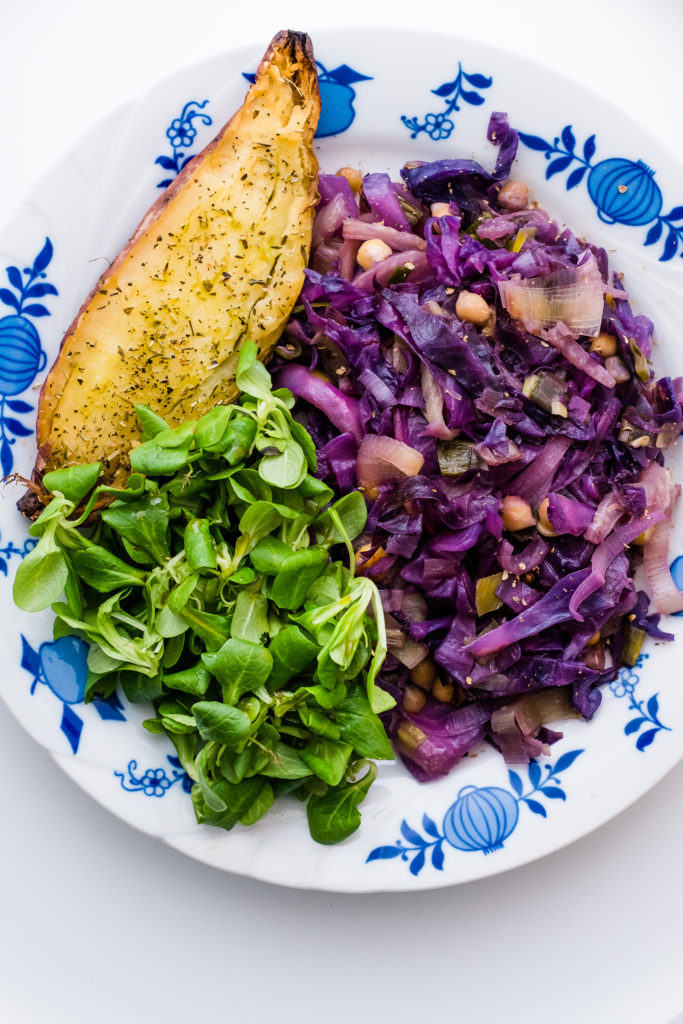
Day 3
Ingredients: EVOO, hemp oil, lentils, red onion, garlic, beetroot, horseradish, Brussels sprouts, cauliflower, coconut milk, chickpeas, asparagus, arugula, mache, olives.
Meal 1: Lentil Stew with Brussel Sprouts and Beetroot Salad (350 calories)
- Sauté onion, then add lentils and seasonings.
- Pair with boiled Brussels sprouts and a beetroot salad mixed with horseradish, olive oil, and apple cider vinegar. Note: Be cautious with horseradish potency.
Meal 2: Cauliflower Mash Bowl with Chickpeas, Asparagus, and Green Salad (470 calories)
- Blend steamed cauliflower with 1/8 cup coconut milk and seasoning.
- Sautee chickpeas with red onion, garlic, and seasonings, in one tablespoon of EVOO (for 2 servings).
- Serve the mashed cauliflower with sautéed chickpeas, steamed asparagus, a green salad, olives, and drizzle with EVOO and apple cider vinegar.
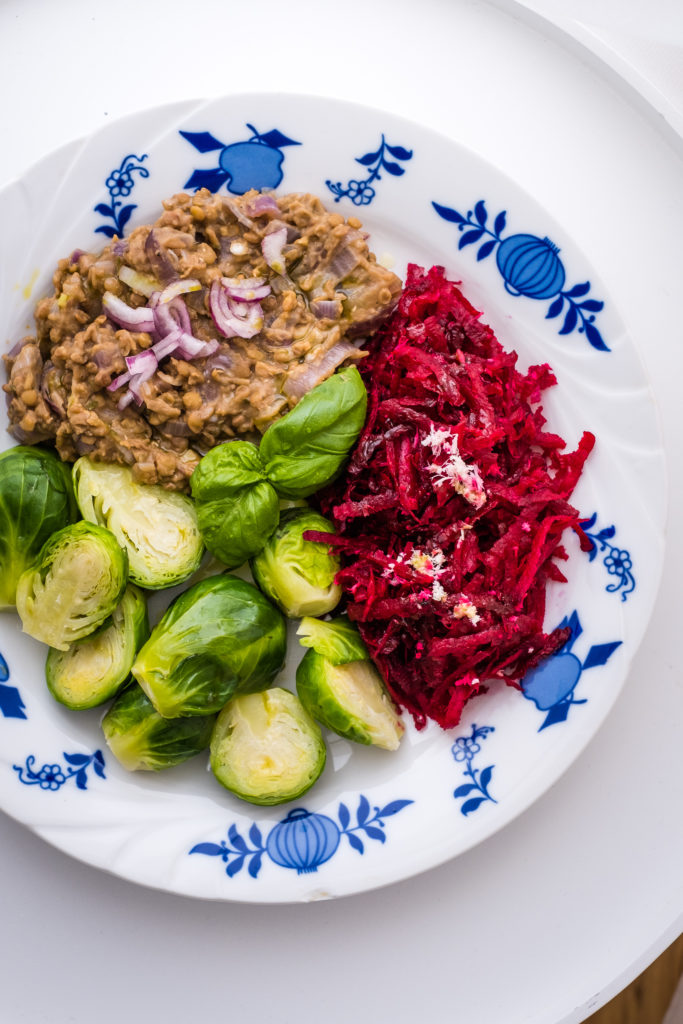
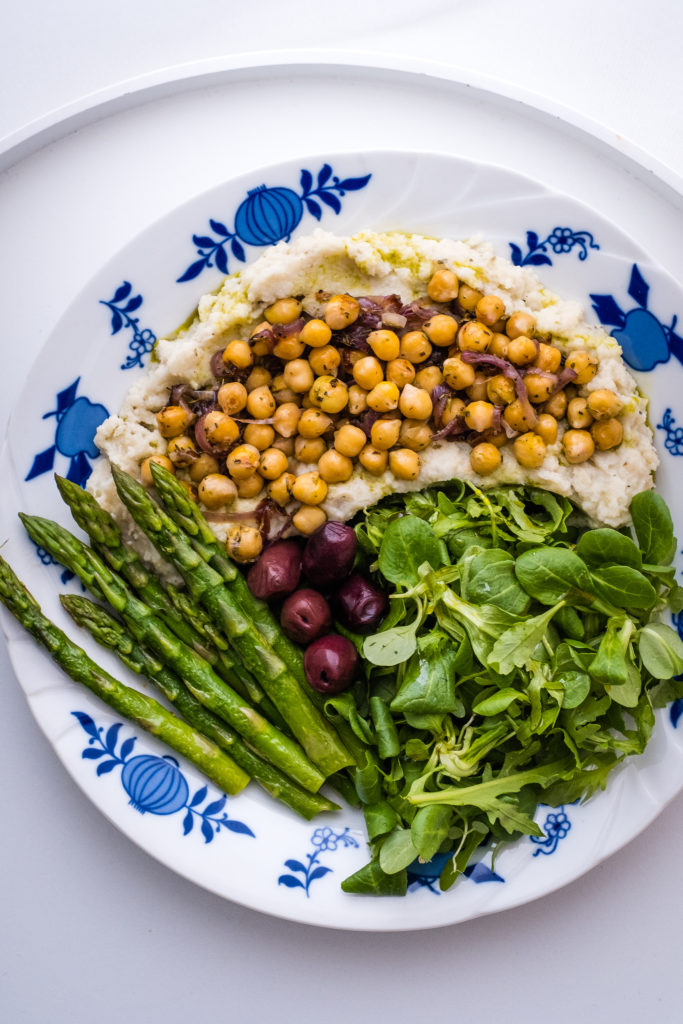
Day 4
Ingredients: EVOO, hemp oil, lentils, red onion, garlic, kale, cauliflower, asparagus, olives, arugula, sweet potato, hummus, cabbage, carrots.
Meal 1: Buddha Bowl with Lentils, Kale, Asparagus, Cauliflower, and Green Salad (350 calories)
- Prepare lentils as in the previous days, but mix in some kale or other leafy greens.
- Accompany with steamed asparagus, cauliflower (raw or steamed), a green salad, fresh herbs, and a drizzle of oil.
Meal 2: Hummus & Sweet Potato Platter with Cabbage Salad (420 calories)
- Serve warmed, pre-cooked sweet potato with a cabbage salad, hummus, raw vegetables, and a green salad. Adjust hummus and sweet potato quantities as desired to meet the required calories.
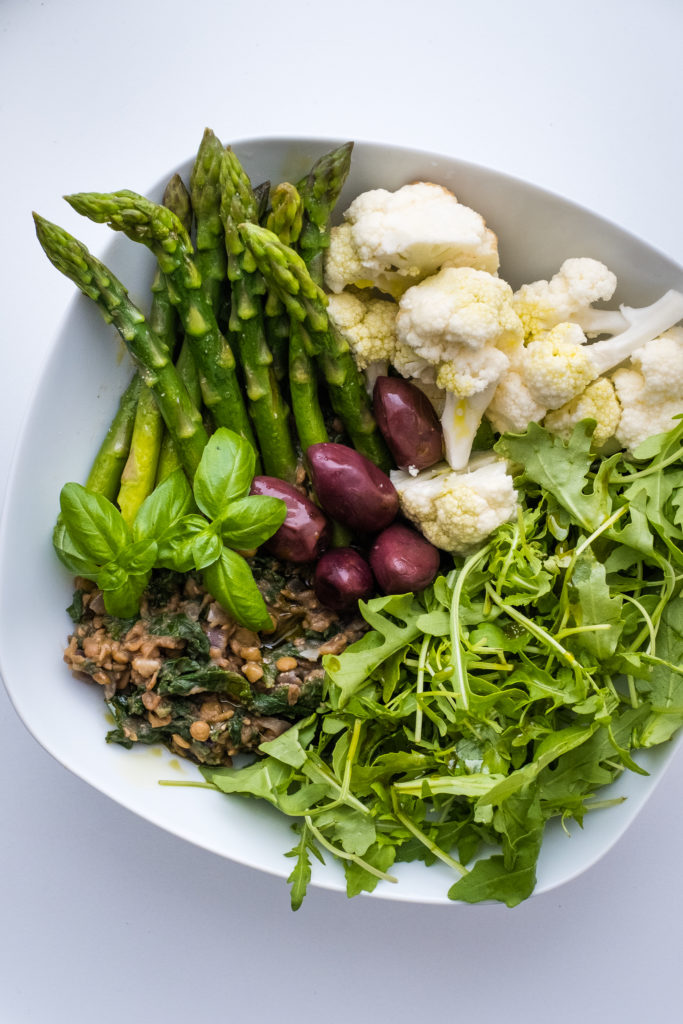

Day 5
Ingredients: EVOO, hemp oil, cabbage, ginger, red onion, garlic, bay leaves, cloves, nutmeg, herbs de Provence, sweet potato, lentils, broccoli, cauliflower, and arugula.
Meal 1: Roasted Cabbage & Sweet Potato (350 calories)
- Prepare cabbage as in Day 2 (varieties like napa or savoy are acceptable) and sauté pre-cooked sweet potato slices in EVOO, with spices (not more than 1/2 medium potato).
- Serve with olives and a sprinkle of hemp seeds.
Meal 2: Buddha Bowl with Lentils, Broccoli, and Crunchy Cauliflower (300 calories)
- This was the Meal Finale, so I didn’t have much inspiration for cooking.
- Combine plain pressure-cooked lentils, raw cauliflower, steamed broccoli, and olives on a bed of arugula. Dress with EVOO and seasonings. You can cook the cauliflower if you prefer.
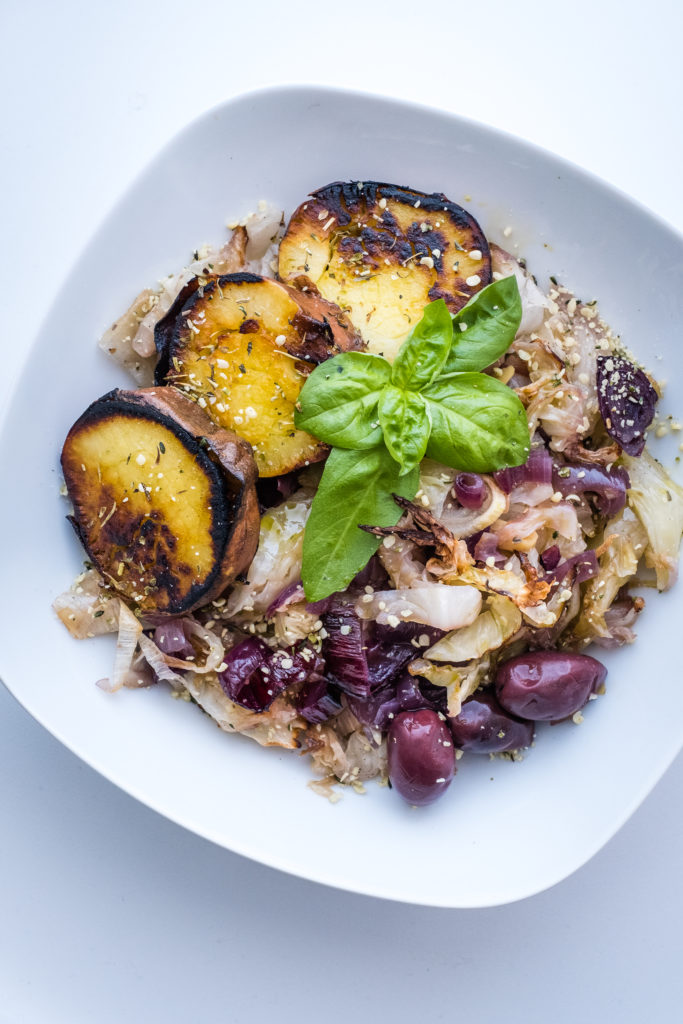

Fasting-Mimicking Diet, Soup Recipes
While creating this plan, I wasn’t initially drawn to soups, but they can be an invaluable addition, especially if you do this fast in the cold season.
Plant-based soups are nutrient-rich, low in calories, easy to prepare, and can replace any of the meals above. They are also great for people struggling to digest raw or minimally cooked vegetables.
General Soup Preparation Method:
- Sauté a mix of finely chopped vegetables, such as onions, leeks, carrots, parsnips, celeriac, celery, and fennel, in EVOO until softened. If needed, add a bit of water.
- Incorporate red bell pepper for flavor if you can eat peppers. I do sometimes, but only after I peel and deseed them, to remove lectins. They add a nice flavor and color to soups.
- Add herbs and seasonings like rosemary, thyme, bay leaves, salt, and pepper, followed by cooked beans of your choice, and water to cover them.
- Simmer for about 10-15 minutes, then add chopped leafy greens, and cook for another 5 minutes.
- Garnish with fresh herbs like dill, parsley, or cilantro, and adjust seasoning as necessary.
Here are a few more soup recipe ideas for the fasting-mimicking diet DIY:
- Creamy Nettle and Cauliflower Soup (You can replace nettles with spinach or kale)
- Cream of Celeriac, Parsnip and Cauliflower
- Low Histamine Cabbage Soup (Skip the chicken)
- Easy, Warming Soup with Cauliflower and Mustard Greens
- Italian Style Mustard Green and Sweet Potato Soup (Skip the prosciutto)
- Healing Vegetable Soup with Kale and Broccoli Sprouts
- Healthy Asparagus Soup (Vegan, Low-Lectin, Low-Histamine)

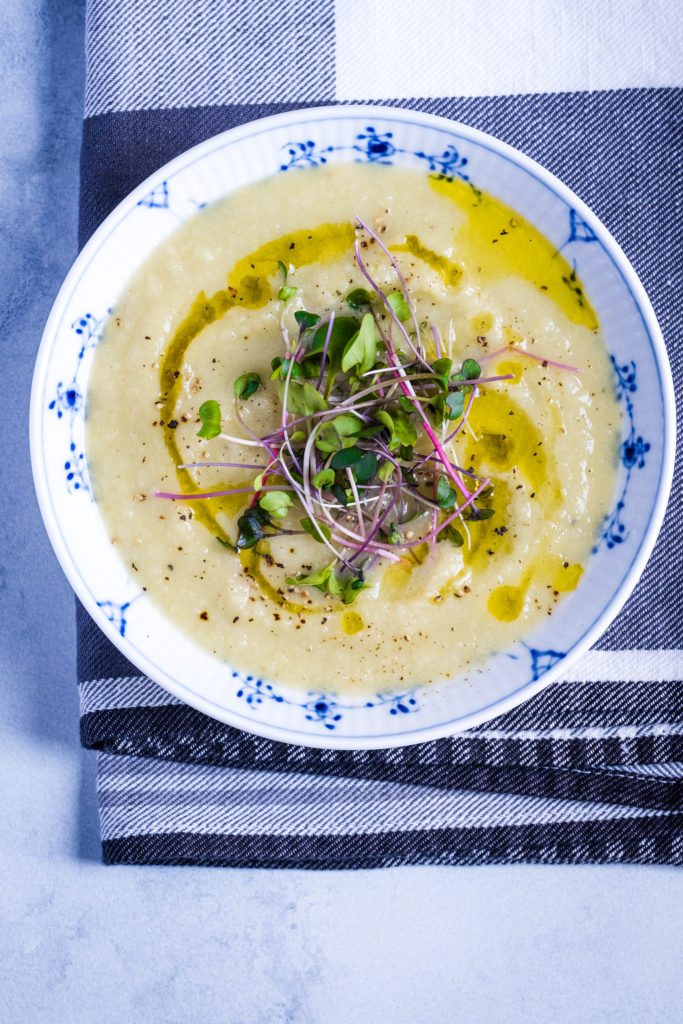
Snacks for the 5-day fasting-mimicking diet meal plan: mini brownie
On Day 4, I felt the urge to switch things up a bit in terms of routine, texture, and taste. So, I whipped up these mini brownies, each tallying up to just 50 calories.
You can also make these on Day 1, to have a low-calorie, satisfying snack on hand during the five days.
- Combine all the dry ingredients in a bowl: 31g of flax meal, 21g of hemp seeds, 10g of cacao powder, 20g of plantain flour, 10g of psyllium husk, 60g of tigernut flour, 30g of chopped walnuts, a pinch of salt.
- Blend the wet ingredients: 60g sweet potato, 20ml coconut milk, 20ml water (add more if necessary).
- Gently combine the wet and dry mixtures until they form a cohesive, slightly sticky dough. Roll the dough between two pieces of parchment paper to about 1/4 inch thickness, or slightly thinner. Then, divide it into approximately 16 equal parts.
- Bake at 140C (285F) for about 25 minutes.
- Note: These bites are not inherently sweet. If you prefer a touch of sweetness, consider adding some inulin powder.
- Calories: Each serving yields roughly 50 calories.
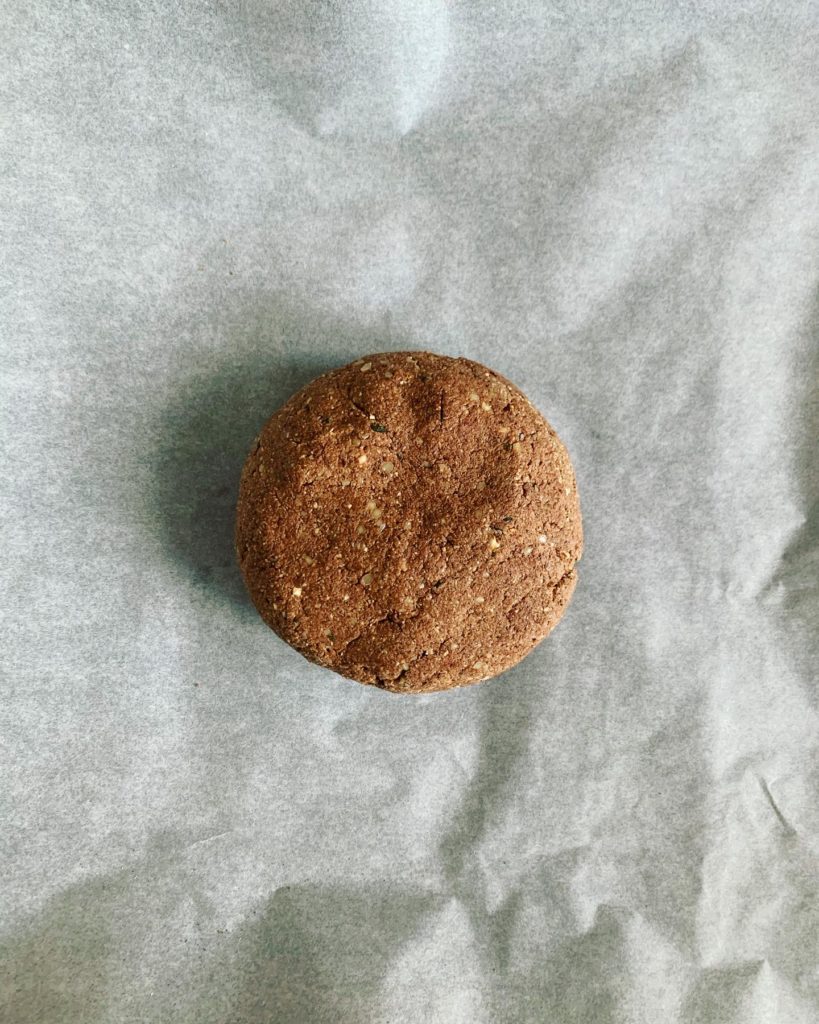

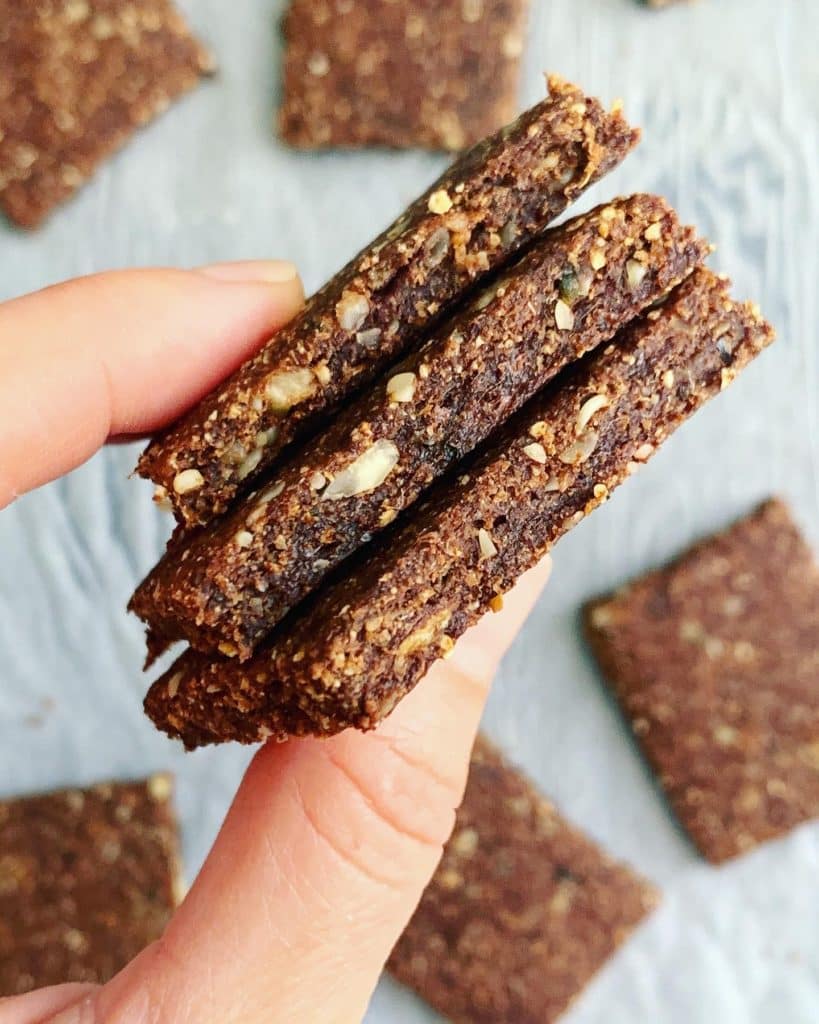
Most days, we had two Brazil nuts for their content of selenium. They have 33 calories each.
Sometimes, when we had more room to play with, we had a few fresh walnuts (we have walnut trees all around here). I did have a few pistachios one day and a couple of freshly boiled chestnuts.
Drinks and supplements for the 5-day fasting-mimicking diet meal plan
Hydration is always vital, but it becomes even more critical during a regimen like the FMD. Aim to consume at least 2 liters of filtered or mineral water daily.
While we chose to include coffee in our plan, this period can serve as an excellent opportunity for those considering a caffeine break.
Matcha and green tea are acceptable, but if you’re thinking of abstaining from caffeine entirely, herbal teas are a fantastic alternative. I particularly love tulsi, lemon balm, dandelion, and fresh ginger tea.
As for supplements, feel free to stick to your regular regimen. However, if you’re unsure, it’s always a good idea to consult your doctor for advice.
Conclusion: Reflecting on the 5-Day Fasting-Mimicking Diet Meal Plan
Embarking on the 5-day fasting-mimicking diet meal plan was an enlightening experience. For me, the most challenging part was the calorie counting, which felt quite foreign and time-consuming.
Although the type of food included in this plan mirrors my regular diet, I typically incorporate more fats, more complex carbs, and animal protein into my daily meals. And I love making and eating healthy, gluten-free, and sugar-free desserts.
Since I practice intermittent fasting regularly, I didn’t feel this was too hard, but I was excited to reintroduce some protein and carbs.
Weight loss insights
I managed to shed approximately 1.5kg, an expected outcome given the severe calorie restriction.
In contrast, my mother lost a remarkable 3.6kg. I believe her more significant weight loss is attributed to the stark difference this diet posed to her regular eating habits.
While weight loss was a noticeable result, the goal of the 5-day fasting-mimicking diet should not be solely weight loss.
Yet, for those seeking a rapid method to shed body fat, particularly around the abdomen, while preserving lean muscle, the FMD diet offers an effective solution.
Enhanced energy and focus
Although it’s challenging to quantify the benefits of fasting, both my mother and I felt a surge in our energy levels and mental clarity.
Hunger was never an issue during the plan. However, I felt a strong urge to reintroduce carbs.
Interestingly, my mother showcased evident signs of entering ketosis but managed to sidestep the infamous ‘keto flu’. Her only complaints were a day-long headache in the beginning and increased thirst.
Her resilience, coupled with a lack of hunger and cravings, even surprised her. When I asked about her success, she cheekily credited her indomitable spirit. In her eyes, once she’s set on a path, there’s no deviating from it (I can confirm that’s true!).
Share your personal journey
It’s important to remember that each individual’s experience will vary.
Always consider seeking advice from a healthcare professional before drastically altering your diet, especially if you’re on medication.
For those who decide to embark on this journey, we would love to hear your personal experiences and insights. It’s truly intriguing to witness the myriad ways in which our bodies respond to dietary shifts.
Other cleanse meal plans
- 3-Day Gut Cleanse. An Easy Plant Paradox Meal Plan
- Low-Lectin Kitchari Recipe for a 3-Day Ayurvedic Cleanse
- 3-Day Cleanse to Lose Belly Fat (Easy Meal Plan)
*This post contains affiliated links, which means I get a small commission if you choose to purchase something via one of my links, at no extra cost to you.


76 Comments
Deborah
December 27, 2020 at 1:30 pmHi, Claudia–Thanks for this blog. It was so helpful to me because I liked the foods and simplicity of your cooking methods. I tried Dr. Gundry’s 5 day cleanse and was very happy but a little bored with the sameness of meals everyday. Your 5 day Cleanse has a bit more variety and choice on veggies, etc. Your post and Living Well cookbook adds to the Plant Paradox and now Longevity Paradox lifestyle I have chosen for the rest of my life. Thanks again for sharing your knowledge and wisdom–lectin free!
Claudia
December 27, 2020 at 2:08 pmMy pleasure Deborah, so happy to hear that it helps with your own health journey. Thank you so much for taking the time to leave a comment <3
Maria
November 17, 2020 at 10:57 pmHi Claudia,
I finished the 5 day cleanse and extended it an extra day. Not having a pressure cooker, I used the eden mills chickpeas and black beans. But they were too much for me. Although not my goal I did lose 6.5 lbs! My goal was to cleanse from over indulgence in goat cheese and PP compliant vegan, treats. ugh, felt really bloated.
Elimination was not good the first 3 days of the cleanse. So the last couple of days did not have any beans at all. Got my protein from hemp and basil seeds. Made hummus from leftover mashed cauliflower – was delicious! Still feel a little bloated and gassy, but lighter too. Thanks for your inspiration!
Claudia
November 18, 2020 at 1:57 amHi Maria, thank you for your feedback, happy it worked for you. Well done on extending for one extra day and on your weight loss. let us know if you do it again and if you apply any modofications. Maybe less beans would be better for you xx. C
Maria
November 13, 2020 at 3:20 pmThanks so much Claudia! xoxo
Maria
November 12, 2020 at 10:40 pmThank you so much for your wonderful article! Really appreciate the details you spelled out! I started today. But I made a soup of daikon radish, broccoli and kale, soup base was my faux chicken broth, main ingredient nutritional yeast for meal one.
I would like to make the brownie treat but don’t have plantain flour, nor easy fast access to it. So what could I use to substitute for it? Would cassava flour work at the 20g? or would almond flour be better? I also have coconut flour, sorghum and millet flour handy.
Thank you for all your hard work! <3 Looking forward to your answer
Claudia
November 13, 2020 at 2:18 amHi Maria, thank you so much for your kind words. I would use almond flour, or half almond half cassava. You soup sounds delicious xx
Gilbert
July 31, 2021 at 3:34 amHow did we get the measurements per ingredient?
Claudia
August 3, 2021 at 3:33 amHi Gilbert, I’m not sure I understand this comment / your question. Maybe you can expand if you see this reply?
Kelly
January 17, 2023 at 1:56 amI think Gilbert is requesting the measurements for each ingredient in the meal recipes. For example how much onion, leaks, cauliflower.
Claudia
January 17, 2023 at 4:00 amHi Kelly. I have the quantities for the elements that matter – those high in calories (beans, sweet potato, nuts, fats). For the nonstarchy vegetables doesn’t really matter. We can have 4 or 6 florets of broccoli; it’s not going to make a lot of difference. Also, the visuals of my meals are important as a guide.
Nancy
October 18, 2020 at 11:54 pmHi! You sure went to a lot of work to compose this blog post! Thanks for that. I’m not sure if you meant to, but your menu seems to be covered by your lovely photos. Is it just me?
Claudia
October 19, 2020 at 4:09 amHi Nancy! Those are the names of meals as a photo caption. I guess you are on a mobile. I noticed the photo caption looks too big for the picture, but I wouldn’t want to remove that. As per the meal plan, it is as you see it in the blog post (no table because tables didn’t look good in this format). Thank you for your kind words, it was a lot of work 🙂 xx
calvin sturdevant
December 10, 2022 at 9:26 pmI would like to know what I can eat on this plan to replace the green leafy vegetables. I am on warfarin and was instructed by my cardiologist that I need to avoid all green leafy vegetables because the vitamin k interferes with the medicine. I was also diagnosed with celiac, gerd, acid-reflux, poor blood circulation and pre-diabetes.
Claudia
December 11, 2022 at 10:07 amHi Calvin, considering your health problem, I would not do this type of fasting (unless your doctor recommends it and monitors you). I would instead go with the Plant Paradox 3-Day Cleanse – you will find it on the website with the search option. And then follow the plant paradox program until you see some improvements (reading The Plant Paradox by Dr. Steven Gundry will help tremendously). As per the leafy greens, add more of the allowed vegetables in like cruciferous, sweet potatoes, root vegetables, and nonstarchy vegetables like asparagus, artichokes, mushrooms etc. I hope this helps! Best wishes, Claudia
Claudia
December 11, 2022 at 10:10 amAlso, I forgot to mention that uncooked vegetables can be tough on your digestion; that’s why I’d instead go with something where you also consume some animal protein, like the 3-day cleanse (adapt it to suit your needs and your doctor’s recommendations).
DebbsSeattle
March 14, 2023 at 2:04 pmCalvin,
If your warfarin is temporary, Google which to avoid. Mr. Just came off his 90 day post op warfarin protocol. We just limited his veg intake to cucumber, tomato, iceberg, cauliflower, carrots, celery. His spinach was served 20 leaves per portion, broccoli at 2 spears, avocado at a slice as garnish. If you are a permanent warfarin patient, ask your physician to share their recommendations for weekly consumption. For the rest of your ailments, I recommend doing some Google research on “repairing gut health” or “restoring the gut micro biome”. Steven Gundry, Pradheep Jamnadas, Ben Bickman, Eric Berg…all Dr.s with YouTube content…provide plenty of rabbit holes to jump down. In the meantime, the easiest steps are #1: cut out, as in eliminate sugar. Literally, remove it from your home, place it in the trash. Do not replace it with any other sweetener, except honey and only by the 1/2 teaspoon full here and there. #2: move to a whole food diet, eliminate anything from a box or a can, or a barcode with more than one ingredient. Within 90 days you can literally reverse all your symptoms of ill health like we did.
Melinda
February 1, 2023 at 9:23 amWhy does Day 1 only have around 600 calories?
Claudia
February 1, 2023 at 9:51 amHi Melinda, good question. The first meal had only non-starchy vegetables, but it was so filling and a pretty big portion that it was all we needed. I also left some room for a few nuts or a few olives to snack on.